Barrett M107A1 ,50 BMG Semi Automatic Fluted Barrel Rifle, Black – 18062 For Sale
$12,999.99
The Barrett M107A1, model 18062, is a state-of-the-art .50 BMG semi-automatic rifle that epitomizes modern firearm engineering. Building on over 35 years of research and feedback from elite military users, this rifle evolves Barrett’s legacy with a focus on advanced design and performance standards. Reimagined with cutting-edge manufacturing techniques and materials, the M107A1 is four pounds lighter yet stronger than its predecessors, enhancing portability and effectiveness. It is optimized for sound suppressor compatibility, crucial for reducing combat visibility. Designed for precision and versatility, the M107A1 includes features like a lightweight QD Titanium Bipod, a suppressor-ready muzzle brake for recoil management, and backup iron sights, making it an exceptionally accurate and durable weapon. This rifle represents Barrett’s masterful blend of innovation and tradition, designed to meet the demands of contemporary warfare.
What is the difference between M107A1 and M82A1?
The M107A1 and M82A1 are both .50 caliber sniper rifles developed by Barrett Firearms Manufacturing, but they have some distinct differences:
1. **Weight and Portability**: The M107A1 is designed to be lighter than the M82A1, making it more portable for military operations. This is achieved through the use of different materials and design optimizations.
2. **Materials**: The M107A1 uses more advanced materials, such as titanium for certain components, to reduce weight and improve durability.
3. **Suppressor Capability**: The M107A1 is engineered to be suppressor capable and can be used with a Barrett-supplied suppressor. This feature is not inherently part of the M82A1 design.
4. **Design Improvements**: The M107A1 includes various design enhancements that improve its overall performance and reliability, such as a revised muzzle brake, a more efficient recoil system, and optimized for use with a suppressor.
These differences make the M107A1 a more modern and versatile option, particularly for military applications requiring greater mobility and versatility in suppression.
Can you legally own a Barrett 50 cal?
In the United States, you can legally own a Barrett .50 caliber rifle, but this is subject to federal, state, and local laws. Under federal law, the Barrett .50 cal is classified as a long gun, which is generally legal to own for civilians who are not prohibited from possessing firearms. However, certain states and localities have enacted their own regulations that may restrict or ban the ownership of .50 caliber rifles. It is important to check the specific laws in your state or locality to ensure compliance. Additionally, standard procedures such as background checks and adherence to age requirements will apply when purchasing this type of firearm.
What is the range of the m107a1 sniper rifle?
The Barrett M107A1 sniper rifle has an effective range of approximately 1,800 meters (about 1,970 yards), although it can achieve longer distances in skilled hands and under optimal conditions.
Are Barrett rifles worth the money?
Whether Barrett rifles are worth the money depends on various factors such as the intended use, budget, and personal preferences. Barrett rifles, particularly their .50 caliber models, are renowned for their long-range accuracy, durability, and build quality, often being used by military and law enforcement agencies worldwide. For professional or specialized tasks like long-range shooting, target practice, or certain hunting scenarios, they can be considered worth the investment due to their performance and reliability.
However, for casual or recreational shooters, the high cost—which can reach several thousands of dollars—might not justify the purchase compared to other more affordable rifles that might meet their needs. Additionally, the cost of ammunition for larger calibers can be expensive. Ultimately, the value of a Barrett rifle is subjective and should be evaluated based on an individual’s specific requirements and financial situation.
Is the 416 Barrett better than the 50 BMG?
The comparison between the .416 Barrett and the .50 BMG (Browning Machine Gun) depends largely on the specific criteria being evaluated, as each cartridge has its own strengths and ideal use cases.
1. **Ballistics and Range**: The .416 Barrett is known for its high ballistic coefficient and superior long-range performance. It can achieve flatter trajectories and higher velocities, making it exceptionally accurate at extreme distances, which is advantageous for precision shooting.
2. **Power and Impact**: The .50 BMG is renowned for its immense power and stopping capability. It delivers significantly more energy upon impact, making it suitable for anti-material roles and targets that require more force to penetrate.
3. **Recoil and Weight**: In general, the .416 Barrett has less recoil compared to the .50 BMG. This could be beneficial for shooters who need to maintain precision and comfort during extended shooting sessions.
4. **Availability and Cost**: The .50 BMG is more widely available and has a long history of military use, translating to more widespread production and ammunition availability. The .416 Barrett, being a newer and more specialized cartridge, might be more expensive and less readily available.
5. **Applications**: The .416 Barrett is often preferred for precise sniper roles and long-range competitions where accuracy is paramount. The .50 BMG is typically used in military applications for its stopping power and anti-material capabilities.
In conclusion, neither cartridge is universally “better” than the other; it depends on the user’s specific needs and context. For precision long-range shooting, the .416 Barrett may be preferred, whereas for sheer power and versatility in a combat or anti-material context, the .50 BMG might be the better choice.
Is the M107 a sniper rifle?
Yes, the M107 is a sniper rifle. It is a long-range, anti-material sniper rifle used by military forces and manufactured by Barrett Firearms Manufacturing.
What states ban 50 cal rifles?
As of the latest available information, California is the state that bans the sale, transfer, and possession of .50 caliber rifles. Specific laws can change, so it’s important to check the most recent regulations for any updates or changes in legislation.
What does BMG stand for in guns?
In the context of guns, BMG stands for “Browning Machine Gun.” This is often associated with the .50 BMG cartridge, which was designed for the Browning M2 machine gun.
Can you hunt deer with a Barrett 50 cal?
Yes, in general, you can hunt deer with a Barrett .50 caliber rifle, as it is a legal firearm for hunting in some regions. However, this type of rifle is typically overpowered for deer hunting due to its size and power, which are designed for long-range and armor-piercing capabilities. It is important to be aware of and comply with local hunting regulations, which may have restrictions on the caliber and type of firearms that can be used for hunting specific game. Always prioritize ethical hunting practices and ensure that your equipment is appropriate for hunting the intended game.
What sniper did Chris Kyle use?
Chris Kyle used several sniper rifles during his military service, with one of the most notable being the McMillan TAC-338 sniper rifle. He also used the Mk 12 Special Purpose Rifle and the Barrett M82, among others.
What sniper rifle is used by secret service?
The U.S. Secret Service typically uses a variety of firearms depending on the mission requirements, but one of the sniper rifles frequently used by their tactical teams is the FN SCAR 20S. This rifle provides the precision and reliability needed for protective operations. However, specific details about the weapons used can change and may be subject to operational security considerations.
What is the best sniper rifle in the world?
Determining the “best” sniper rifle in the world can be subjective and depends on specific factors such as intended use, shooting conditions, budget, and personal preference. However, some sniper rifles are frequently mentioned among the top due to their performance, precision, and reliability:
1. **Accuracy International AWM (Arctic Warfare Magnum)** – Known for its accuracy and effectiveness at long range. It has been used by various military forces worldwide.
2. **Barrett M82/M107** – A semi-automatic anti-materiel sniper rifle known for its long range and powerful .50 BMG rounds.
3. **Sako TRG 42** – Praised for its precision and engineering, suitable for long-range target shooting.
4. **CheyTac M200 Intervention** – Known for its extreme long-range capabilities, often featured in media and demonstrations.
5. **Remington MSR (Modular Sniper Rifle)** – A versatile and adaptable rifle, well-regarded for its modularity and performance.
Each of these rifles has its own unique qualities that make it suited for different scenarios, and the best choice ultimately depends on the specific needs of the shooter.
Can a civilian own a TAC 50?
Yes, a civilian can own a TAC-50 rifle in the United States, provided they comply with federal and state laws regarding firearm ownership. The TAC-50 is categorized as a long-range sniper rifle, and while it is legal to purchase for civilian use, buyers must adhere to all applicable regulations, including background checks and any specific state requirements. Laws can vary, so it’s essential to be informed about the regulations in your particular state or country.
In what states is full auto legal?
In the United States, the ownership of fully automatic firearms is regulated under federal law by the National Firearms Act (NFA) of 1934 and the Firearm Owners Protection Act of 1986. However, they are not outright banned. Some states have their own laws regarding the possession of fully automatic weapons, but generally, they are legal to own under federal law if they were manufactured before May 19, 1986, and if you comply with all NFA regulations, including background checks, registration, and tax stamps.
Here are the states where civilian ownership of pre-1986 fully automatic weapons is generally legal, subject to NFA regulations and any additional state laws:
1. Alabama
2. Alaska
3. Arizona
4. Arkansas
5. Colorado
6. Connecticut
7. Florida
8. Georgia
9. Idaho
10. Indiana
11. Kentucky
12. Louisiana
13. Maine
14. Maryland
15. Massachusetts
16. Michigan
17. Mississippi
18. Missouri
19. Montana
20. Nevada
21. New Hampshire
22. New Mexico
23. North Carolina
24. North Dakota
25. Ohio
26. Oklahoma
27. Oregon
28. Pennsylvania
29. South Carolina
30. South Dakota
31. Tennessee
32. Texas
33. Utah
34. Vermont
35. Virginia
36. Washington
37. West Virginia
38. Wisconsin
39. Wyoming
Note that some states may have additional requirements or restrictions regarding fully automatic weapons, and laws can change. It’s essential to consult local laws and regulations, and, often, guidance from legal experts or agencies, when considering ownership of such firearms.
What class is a Barrett 50 cal?
The Barrett .50 cal, specifically the Barrett M82 or M107, is classified as a .50 BMG (Browning Machine Gun) anti-materiel rifle. It falls under Category III in the United States, which includes destructive devices and other large firearms. In terms of civilian classification, it is typically considered a Title I firearm under the National Firearms Act, but due to its specific features and caliber, it may have additional regulations depending on the jurisdiction. Always check local laws for the most accurate information.
| Product Line | M107A1 |
|---|---|
| Action | Semi-Auto |
| Overall Length | 48" |
| Magazines Included | 1 (10 Round) |
Be the first to review “Barrett M107A1 ,50 BMG Semi Automatic Fluted Barrel Rifle, Black – 18062” Cancel reply
Related products
Barrett M107A1
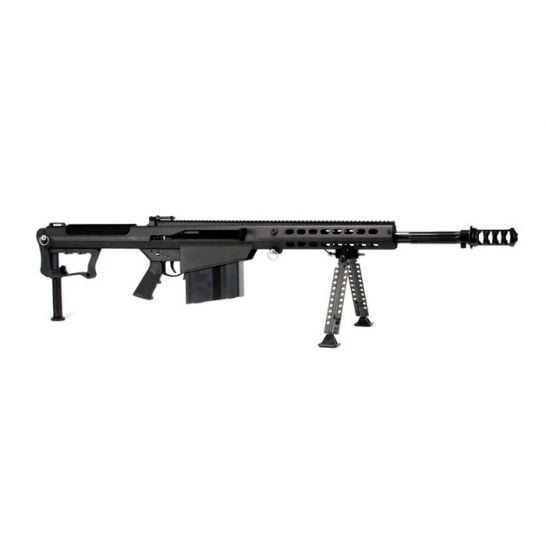
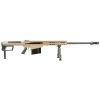
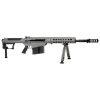
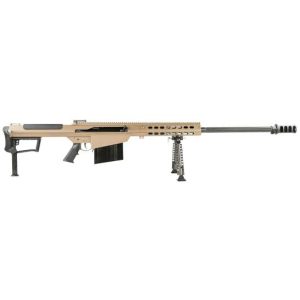
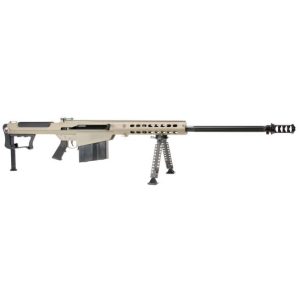
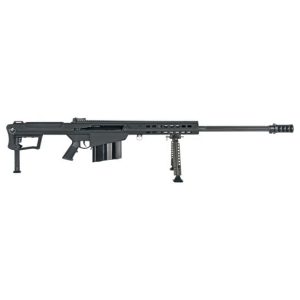
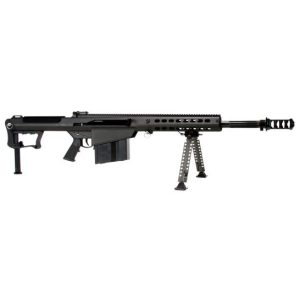
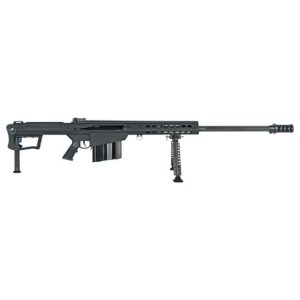
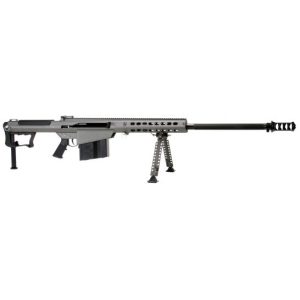
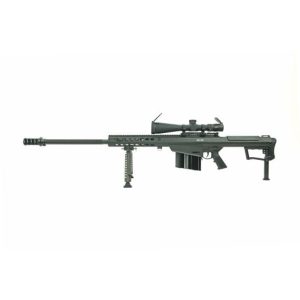
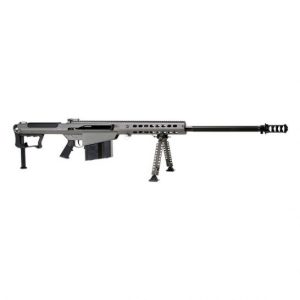
Reviews
There are no reviews yet.